Laboratory consolidation can reduce building operating costs, eliminate redundant space and equipment, and bring teams together to facilitate research and collaboration. Renovating an existing space or building a brand new one serves as an opportunity to create a laboratory space that optimizes productivity and offers the flexibility to adapt to new technology and processes in the future. Achieving these goals requires careful planning and consideration. Chad Zuberbuhler and Cole Brunson, associate principals and planners at Flad Architects, offer some advice on how to properly manage equipment and maximize budgets and space during renovation or new construction.
Analyze and plan
“Often, the process of consolidation will start with a need: additional space, collaboration with others, or the need to reduce operating costs,” says Zuberbuhler. A space assessment study will analyze and inventory the current conditions. “The team doing this study will need to analyze everything about the existing lab, which includes safety concerns, identifying process flows, space utilization per person, linear foot of bench per person, and fume hood and sink per person to develop existing conditions,” he explains. Zuberbuhler notes that this information only pertains to the physical aspect, and that “interviews with lab users can help establish prioritization and improve functional consolidation efforts.”
Equipment planning and management is also an important part of the process. “First, it is important for the client to understand how ongoing research operations will be maintained during construction and commissioning,” explains Brunson. “Vacant swing space can be utilized, or phasing scenarios can be implemented.” Brunson also notes that relocating sophisticated instruments may require recalibration, which should also be factored into the projected timeline for moves.
Use budgets and space effectively
Maximizing budgets during renovation or construction is a top priority for any laboratory. “From a planning standpoint, budgets can be maximized by clearly defining equipment, furnishings, and finishes that match the intended functions,” says Brunson. In some cases, brand new furnishings may not be required. “Building owners and clients can also consider reclaiming and reusing existing lab furniture. Metal casework and tables can be salvaged and repainted to provide years of additional use,” he explains.
Brunson raises another important point: “While maximizing a budget is important, managing the budget during construction is equally important.” He recommends working with a contractor to accomplish both tasks. “Contractors, as well as engineering partners, can offer recommendations on how to reduce costs and often have estimating expertise to cross-check against similar, recent construction projects,” he explains.
Related Article: Laboratory Design and Construction: Translating Success
Many research laboratories contain hundreds of consumables, raw materials, media, and samples that are stored within shelves, cabinets, fridges, and freezers throughout the lab. “One way to maximize space utilization is to provide centrally located, shared storage and/or equipment rooms,” explains Brunson, adding “sharing supplies can reduce the on-hand supply, and dedicated rooms can increase capacity by utilizing high-density storage solutions.” For noisy, heat-generating cold storage units, Brunson recommends creating equipment rooms or fridge/freezer farms to remove this equipment from the primary laboratory environment.
“Modular lab planning with modular utility distribution and open shared lab space can further maximize space utilization within a lab,” adds Brunson. These plans support collaboration among laboratory staff and can account for circulation and workflows within the lab.
Look ahead
Laboratory consolidation also necessitates planning for the future. According to Brunson, “equipment advancements, implementation of automation, future headcounts, and capacities are just a few examples of common unknown variables. Therefore, it is important to build in some level of flexibility to address these unknowns.”
One way to create flexibility is to incorporate movable casework. This enables lab users to reconfigure the laboratory to accommodate new equipment or changing workflows.
“By making informed decisions on future laboratory needs and by making minimal investments for future growth, the client can reduce the amount of disruption and construction costs in the future,” says Brunson. “The renovated or newly constructed spaces should also be routinely re-evaluated to confirm that the labs are continuing to be utilized in an efficient and safe manner.”


